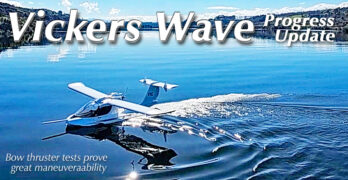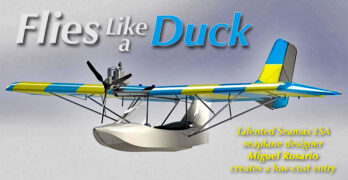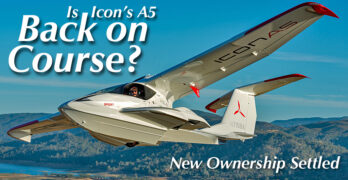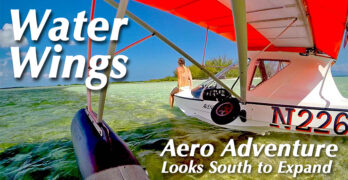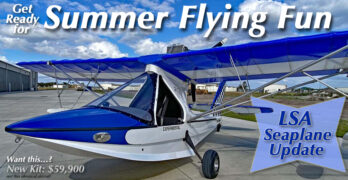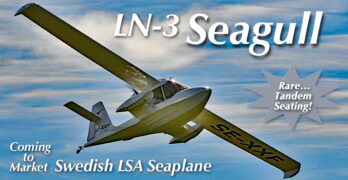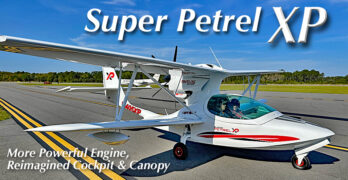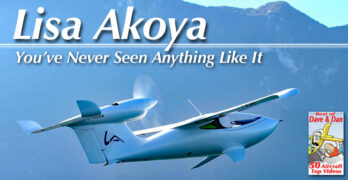Winter is coming, so naturally, it’s time to start thinking about seaplanes… right? It always seems weird to write about water-based activities as frost begins to envelop the northern two-thirds of the country. Yet winter is when all the big boat shows happen because buying new vessels requires advance planning. It’s also pleasant to think about spring and summer while snow flurries fly.
For many years I’ve written about this sector and names like Searey, Seamax, and Aventura (all in nearby image) have long been the leading brands. Now the first two are in financial trouble and the last has decamped to Brazil from Florida. Whatever is going on, Vickers Wave may represent a breath of fresh air.
In articles last fall and this spring, I gave overviews of the entire LSA seaplane market (read here or here).
Vickers Wave Update
Vickers previously noted, “Wave has finished its flight testing, resulting in a 120-knot cruise and useful load of 750 pounds powered by a Rotax 916iS (reviewed here).”
“A frequently asked question I receive is, ‘What is taking so long?’,” begins Paul Vickers.
If It Flies Like a Duck and Floats Like a Duck, Maybe It IS a Duck
Article Updated July 17, 2024 — After this article was posted, Miguel Rosario reported, “Duck is still in tests. Now we will install a 912 ULS 80-horsepower engine, as requested by future customers.” He continued, “Molds are under construction for production, which we hope to start in three months” (approximately October 1, 2024). He finished, “I will keep you updated on all developments regarding Duck.” —DJ
You probably know Seamax. This longtime, performance-oriented LSA seaplane was one of the first to make a splash in the U.S. light aircraft market way back in December, 2007.
Today, regretfully, the Seamax company is going through some very difficult circumstances as noted in this State of the Seaplane Sector report. We don’t know the end of those stories yet.
Nonetheless, Seamax M-22 designer Miguel Rosario remains active. You can’t keep a good man down but apparently you can keep him on the water.
“Icon in Flat Spin,” UK’s Flyer Reported — Here’s the Latest
Icon Aircraft, creator of the A5 LSA seaplane, is in the spotlight again as bankruptcy proceedings finally come to a close.
Short story: Icon will continue making aircraft, after the bankruptcy heard from a new buyer — not the buyer mentioned before in this recent article. The court sought a change in ownership and an effort to grapple with a large amount of debt.
From beginning (in April 2024) to an end in mid-June, this proceeding moved very swiftly. Here’s the final settlement.
“Icon In a Flat Spin
as Bankruptcy Looms”
Earlier in the day on June 18th, 2024…
Britain’s Flyer magazine reported online that Icon found a buyer but not the one mentioned in the prior link.
“Buy an aircraft manufacturer with a certified product and also selling in the Light-Sport Aircraft class for, what? …£100 million? Try again and aim low: just over £12m ($15.3 million),” wrote Flyer staff.
A Seaplane You Can Afford; Aero Adventure Begins a New Chapter for the Aventura Line
Here’s the backdrop of today’s update on the LSA seaplane sector as summer approaches.
According to Law360, an online legal news source, “Light-Sport Aircraft manufacturer Icon Aircraft filed for Chapter 11 protection in Delaware bankruptcy court with more than $170 million in debt and plans for an asset sale and liquidation.” You may have read (here) that Icon got an initial offer of $13.5 million. As an industry contact told me for the earlier report, “That would hardly make a dent in their liabilities.” The person was right, it appears. A proposed new buyer referenced in the earlier article agreed to take on Icon’s debt but the sales must still go through an auction process, I was told.
OK, let’s come back to Earth… or water perhaps …or either. Aero Adventure continues to fly as it has for three decades (though management has changed at least three times over the period).
New Buyer for Icon Reported — What Happens Now?
Icon is a global enterprise. While its headquarters remains in Vacaville, California, fabrication is done in Mexico, and ownership is in China. For some years, this American start-up has benefitted from Chinese investment.
How much investment has this California company attracted? Numbers I’ve been quoted vary enormously but all estimates run into many millions of dollars. If these guesses are even close to accurate, Icon has generated more investment funding than nearly any LSA producer. Only one outstrips them. That was a reported $200 million sale of Pipistrel to Textron, owner of Cessna and other aviation brands. I hope the aerospace conglomerate got all they hoped for because that is a super-premium valuation for any LSA company, even one as tech-savvy as Pipistrel.
Icon has performed reasonably well in recent years (“200 Delivered” report) but prior investments in the company require sales volumes that are difficult to reach, especially with a $400,000 price tag.
Summer’s Almost Here! State-of-the-Sector Report for LSA Seaplanes
One of the most active sectors in light aviation is LSA seaplanes. We’ve seen ups and downs, arrivals and departures of LSA seaplane producers. Admittedly, these flying machines are more complex than current-day LSA. For example, amphibs need retractable landing gear and substantial boat hulls able to take water loads.
LSA seaplanes constitute a highly fluid market yet we can see clues suggesting what might be ahead for some of the main brands. With summertime approaching, this State-of-the-Sector article attempts to keep up with the rapidly changing landscape (or waterscape).
We’ll first look at two high-end entries that have been in the news and conclude with present LSA seaplanes and their status in the market.
Vickers Wave
Writing for AVweb (part of Firecrown, which also owns Flying and ByDanJohnson.com plus several other publications), my fellow aviation journalist Russ Niles stated, “New Zealand-based Vickers Aircraft Company says it intends to make its first delivery of the Wave two-place amphibious aircraft to a U.S.
Swedish LN-3 Seagull — Tandem-Seating LSA Seaplane …Plus, Breaking News!
LSA seaplanes are a segment all to themselves. [See Breaking News at bottom!]
It isn’t only that seaplanes can offer “triphibian” capabilities (a term once promoted by MVP) because they can operate from land, water, or snow. That makes them versatile but amphibious craft must incorporate retractable gear and since they require a sturdy hydrodynamic boat hull as well as aerodynamic aircraft structures, the engineering task becomes significantly larger than land plane designs.
Icon took years with their A5 and Vickers is still working on their Wave. Both took more than a decade to reach market. Several other LSA seaplane projects required similarly lengthy development.
Now from Svenska Flygfabriken (Swedish Aviation Factory) comes LN-3. This new entry is distinctive because it is a tandem-seating seaplane. Yes, I know lots of Cub-types on floats are tandem but among boat-hulled seaplanes, I’m not aware of any others like this.
Super Petrel XP Arrives in Florida; Proven Product Significantly Upgraded
A few days ago a couple Super Petrel XPs arrived in Florida. In no time, Roger Helton‘s team had the pair assembled and had earned their Special Airworthiness Certificates, from two different FAA inspectors no less.
Development happens fast in light aviation; Mosaic will further quicken the pace.
Welcome to Light-Sport Aircraft where the swift thrive and those that can’t move fast enough fall behind. LSA is a market full of seasoned competitors. They’ve learned their trade well, surviving and some even gaining during the Covid upset. Any new creation coming to market will be measured against tough standards.
You think the pace of development is fast now? Wait as Mosaic approaches and company after company announces new products to take advantage of the “Christmas in July” list of new privileges FAA offered in the summer release of their Mosaic proposal (view list at bottom). The regulation is currently in review by the agency and according to their own statements, it should go live by second quarter 2025 (2Q25).
Upping the Ante Pre-Mosaic — Icon Bumps Useful Load of A5 LSA Seaplane
Mosaic is coming! Are you ready?
OK, Mosaic is still around 15 months away (based on FAA’s often-repeated statement). But good companies plan ahead for changes they can foresee. Icon is moving to increase capabilities on their A5 LSA seaplane… plus, the company is responding to customers who gave feedback to the California aircraft manufacturer.
As most readers now know, Mosaic LSA can be larger and therefore they can carry more. While these airplanes remain more than a year from first deliveries current LSA models are expanding their capacities in preparation.
Go Bigger!
Icon Aircraft released news about the 2024 A5. “After nearly two years of rigorous R&D, testing, and production preparation, Icon is excited to announce that it has increased the gross weight of the A5 by 60 pounds, resulting in a new useful load of 490 pounds (up from 430 pounds),” the company stated.
This change comes from a gross weight increase to 1,570 pounds.
Top 50 Video Review: Lisa Akoya, an Innovative, Sleek LSA Seaplane
“Lisa Akoya: You’ve Never Seen Anything Like It,” trumpeted the lead image. Ten-year-on translation: “You’ve never seen it.”
Inspired design, cutting edge ideas, elegant sleekness, and unique features set the French LSA seaplane apart and may inspire successive designs but Lisa’s Akoya never made it to market.
No wonder,” exclaimed some! More than a decade back, they approached a retail price of $400,000. After ten years of dollar inflation, that number would be way past $500,000 today.
Remarkable as it may be to those of us with normal incomes, buyers for high-end products seem often to emerge. Cirrus and their steady sales of million-dollar-plus four seaters is proof of that. To appeal to such well-heeled pilots, a company better deliver a beautiful, functional, well-supported aircraft. Doing that expertly at a premium level gets expensive.
Here’s Looking at Lisa
Lisa Akoya dates to the very beginning of Light-Sport Aircraft. In 2004, two aviation enthusiasts, Erick Herzberger and Luc Bernole, established Lisa Airplanes in the heart of the French Alps.


